Pennsylvania's congressional districts

After the 2000 Census, the Commonwealth of Pennsylvania was divided into 19 Congressional Districts, decreasing from 21 due to reapportionment. After the 2010 Census, the number of districts decreased again to 18.
Current districts and representatives
List of members of the Pennsylvanian United States House delegation, their terms, district boundaries, and the districts' political ratings according to the CPVI. The delegation has a total of 18 members, with 13 Republicans, and 4 Democrats with 1 vacancy.
| District | Representative | Party | CPVI | Incumbent time in office | District map |
|---|---|---|---|---|---|
| 1st |  Bob Brady (D-Philadelphia) Bob Brady (D-Philadelphia) |
Democratic | D+28 | May 19, 1998 – present | .tif.png) |
| 2nd | 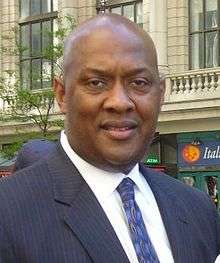 Dwight Evans (D-Philadelphia) Dwight Evans (D-Philadelphia) |
Democratic | D+38 | November 14, 2016 – present | .tif.png) |
| 3rd | 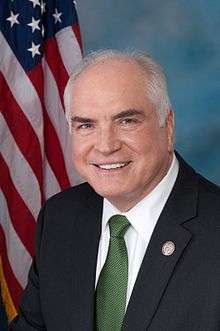 Mike Kelly (R-Erie) Mike Kelly (R-Erie) |
Republican | R+8 | January 3, 2011 – present | .tif.png) |
| 4th | 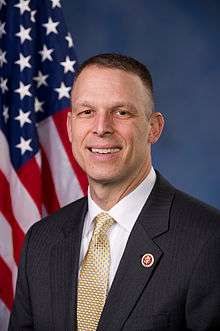 Scott Perry (R-Harrisburg) Scott Perry (R-Harrisburg) |
Republican | R+9 | January 3, 2013 – present | .tif.png) |
| 5th | .jpg) Glenn Thompson (R-Oil City) Glenn Thompson (R-Oil City) |
Republican | R+8 | January 3, 2009 – present | .tif.png) |
| 6th | 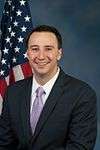 Ryan Costello (R-West Chester) Ryan Costello (R-West Chester) |
Republican | R+2 | January 3, 2015 – present | .tif.png) |
| 7th |  Pat Meehan (R-Philadelphia/Reading) Pat Meehan (R-Philadelphia/Reading) |
Republican | R+2 | January 3, 2011 – present | .tif.png) |
| 8th |  Mike Fitzpatrick (R-Levittown) Mike Fitzpatrick (R-Levittown) |
Republican | R+1 | January 3, 2011 – present | .tif.png) |
| 9th | |
Republican | R+14 | May 15, 2001 – present | .tif.png) |
| 10th |  Tom Marino (R-Williamsport) Tom Marino (R-Williamsport) |
Republican | R+12 | January 3, 2011 – present | .tif.png) |
| 11th |  Lou Barletta (R-Harrisburg) Lou Barletta (R-Harrisburg) |
Republican | R+6 | January 3, 2011 – present | .tif.png) |
| 12th | 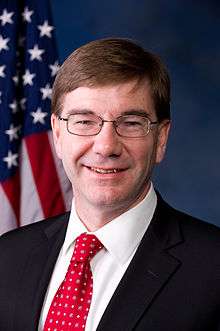 Keith Rothfus (R-Oakmont) Keith Rothfus (R-Oakmont) |
Republican | R+9 | January 3, 2013 – present | .tif.png) |
| 13th | 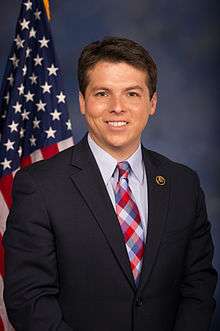 Brendan Boyle (D-Philadelphia) Brendan Boyle (D-Philadelphia) |
Democratic | D+13 | January 3, 2015 – present | .tif.png) |
| 14th | 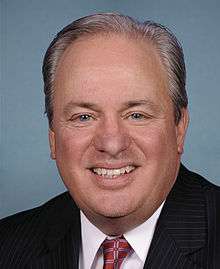 Michael Doyle (D-Pittsburgh) Michael Doyle (D-Pittsburgh) |
Democratic | D+15 | January 3, 1995 – present | .tif.png) |
| 15th |  Charlie Dent (R-Allentown) Charlie Dent (R-Allentown) |
Republican | R+2 | January 3, 2005 – present | .tif.png) |
| 16th |  Joseph Pitts (R-Reading) Joseph Pitts (R-Reading) |
Republican | R+4 | January 3, 1997 – present | .tif.png) |
| 17th | 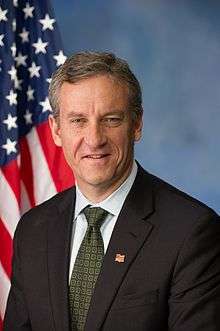 Matthew Cartwright (D-Scranton) Matthew Cartwright (D-Scranton) |
Democratic | D+4 | January 3, 2013 – present | .tif.png) |
| 18th |  Tim Murphy (R-Brentwood) Tim Murphy (R-Brentwood) |
Republican | R+10 | January 3, 2003 – present | .tif.png) |
Partisan split

Blue - Democrats (5)
2012 Congressional District Realignment
The Congressional Districts in Pennsylvania faced slight realignment for the 2012 election. Many sitting Congressional Representatives saw their districts modified or merged as part of the redistricting. An example of this would be the previous District Four (4) and Twelve (12). These two district saw major changes with the new realignment. The merger forced a primary runoff between the two sitting representatives in order to determine who would hold seat for the newly formed district.[2]
Historical district boundaries
-

Districts from 2005 - 2013
Redistricting in Pennsylvania
The process of drawing district boundaries, or redistricting, in Pennsylvania is described here[3] and here.
Since the 2010 Census and the 2012 elections, redistricting in Pennsylvania has been controlled by Republicans, who have driven the process to maximize partisan advantage. In 2012, Democrats won slightly more than 50% of the total vote in Pennsylvania Federal House elections,[4](50.5% in fact), yet only five of the state's 18 Federal Representatives are Democrats, as those voters have been intentionally concentrated in as few districts as possible.[5]
See also
References
- ↑ "The national atlas". nationalatlas.gov. Retrieved February 22, 2014.
- ↑ http://www.politicspa.com/pas-new-congressional-maps/30096/
- ↑ "Redistricting in Pennsylvania (Ballotpedia)".
- ↑ http://www.nytimes.com/2015/12/06/opinion/sunday/let-math-save-our-democracy.html?mabReward=A7&moduleDetail=recommendations-2&action=click&contentCollection=Opinion®ion=Footer&module=WhatsNext&version=WhatsNext&contentID=WhatsNext&src=recg&pgtype=article
- ↑ "2012 Pennsylvania House Election Results". Politico. Politico LLC. Retrieved 9 October 2014.